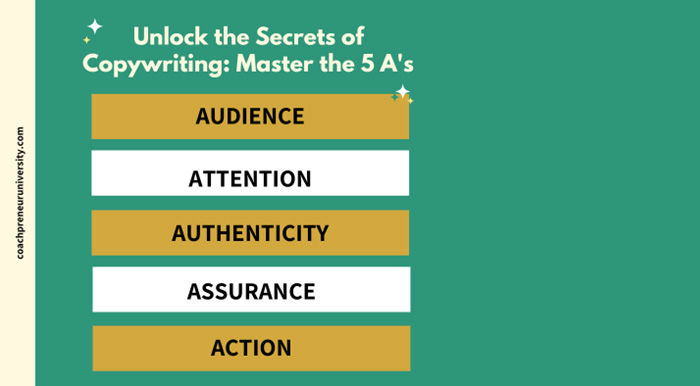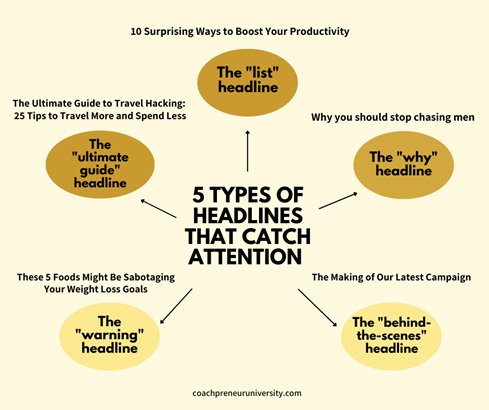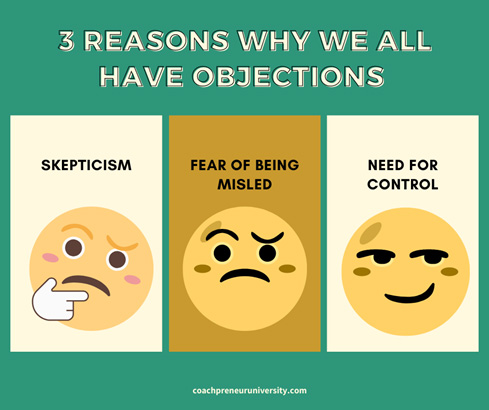Unlock the Secrets of Copywriting
Guest Post by Ms. Dori - Master the 5 A's to start writing copy that converts

Are you one of those people who think that copywriting is just about drafting a persuasive "buy my stuff!" sales page?
If so, I hate to break it to you, but you're missing this critical marketing skill's true power and potential.
In reality, copywriting is much more than writing persuasive keywords. Instead, It is a multifaceted discipline combining elements of psychology and marketing to construct compelling messages that resonate with your readers.
But don't worry if you feel overwhelmed by the idea of mastering copywriting because today I'm going to introduce you to the 5 "A" s of copywriting, which are the building blocks of effective online writing skills. Once you understand and apply them, you'll be able to create compelling messages that speak directly to your target audience. The five essential elements are Audience, Attention, Authenticity, Assurance, and Action.
Whether you're writing social media captions, blog posts, email newsletters, or sales pages, copywriting is essential to modern communication that requires creativity, strategy, and finesse. Therefore, mastering the 5 "A" s can make all the difference in the world.
So, if you're ready to take your copywriting skills to the next level and start crafting messages that truly resonate with your readers, read on to learn more about each of the 5 "A" s and how you can apply them to your own copywriting.
The first A is your "Audience."

When it comes to online writing if you don't know who your target audience is, then you might be writing an autobiography - because no one else will care!
But discussing this subject can be tricky because let's face it, who doesn't want to reach as many people as possible? That's what I thought when I first started online marketing.
I used to believe that selling to everyone was the key to success. And just like most marketers out there, the idea of narrowing down my target audience didn't sit well with me. I thought by doing so, I would be limiting my potential customer base and missing out on sales opportunities.
My approach of "talking to everyone" worked for a while, but as I began to expand my marketing efforts, I started to feel a lack of interest from my audience.
That's when I started narrowing the focus to a particular audience. As I began to do so, I quickly saw the benefits of this approach and here's why.
Because when your marketing message is too broad, it may not speak directly to the needs and desires of any particular individual, which can result in a lack of interest and engagement.
On the other hand, by narrowing down your target audience, you could tailor your messaging and offerings to meet your ideal customers' needs better, leading to higher conversion rates.
But if you're worried about missing possible sales opportunities, I can assure you that focusing on a particular audience doesn’t mean you couldn't serve others interested in your services. Instead, it means that you are going to focus on one specific audience at the moment until you’ve established a solid customer base and gained some traction. Once this is achieved you can expand your circle and cater to other customers.
You need a customer profile to identify your target audience
So how do you identify your ideal audience?
The answer is by creating a customer profile. A customer profile will help you understand your target audience's pain points, desires, and motivations. Knowing what they want will help you increase sales, and it can help you market your product and services effectively, such as lead generation, branding, content marketing, and more.
By identifying your audience's needs and preferences, your marketing plan is more likely to be successful because here's the bottom line, if your copy resonates with your target audience, your product and services will pretty much automatically sell themselves because when you understand your audience's needs, you're able to craft a message that aligns with your audience's worldview and connects with their emotions, it becomes much more persuasive and compelling.
If you want to learn more about how to create a customer profile, You can download my free worksheets HERE.
Once you have this information, you can tailor your message to appeal directly to your audience, using Language and phrasing that they can relate to and that speaks to their needs and desires, increasing engagement and driving more conversions and sales.
Let's say you're a fitness coach. Here's the difference between writing for a 40-year-old mom of 3 might differ from writing for a 65-year-old retiree:
When writing for a 40-year-old mom of 3, your Language and tone could be modern and conversational, using phrases like "meal prep" or "time-saving tips" that are likely familiar to this demographic. In addition, the tone might be upbeat and encouraging, emphasizing the idea that meal planning can save time and reduce stress for busy moms.
However, when writing for a 65-year-old retiree, the Language used could be straightforward and easy to understand, emphasizing clarity and simplicity. The tone might be more informative and authoritative, highlighting the benefits of meal planning for seniors, such as the importance of good nutrition and the potential cost savings. The tone could also be more reassuring, as older adults may be concerned about their health and finances.
In both cases, the Language used is tailored to each demographic's specific interests, needs, and preferences. By understanding who your readers are and what motivates them, you can create content that resonates with them and keeps them engaged with your website or blog.
With that said, this knowledge can help inform decisions on topics and the depth of information covered–it helps narrow down where the focus should be when crafting a piece of content. In addition, having an idea of what kind of person is likely to read what you are writing makes it easier to create something significant that speaks directly to their interests.
The second A is “Attention”
Have you ever browsed the internet and stopped on something that really caught your eye?
In a world where we're bombarded with information from all directions, our audience's attention spans are shorter than ever.
Studies have shown that the average attention span of an adult is only eight seconds. That's why it's essential to make every second count when it comes to capturing our audience's attention.
An attention-grabbing headline can "hook" your readers, create interest, and compel them to keep reading. In contrast, a dull or uninteresting headline and hook can turn readers away and cause them to move on to something else.
5 types of headlines that catch the attention

This headline format appeals to the reader's curiosity and desire for knowledge. People are naturally curious and want to know the reasons behind things, so this headline promises to answer their questions and provide valuable insights. It's also effective because it creates a sense of urgency and importance.
● The "list" headline: 10 Surprising Ways to Boost Your Productivity
Believe it or not, lists are super popular because the human brain is wired to respond well to numbered lists, and this headline format promises to provide valuable information in an easy-to-read format. In addition, it gives people a sense of completeness and satisfaction.
● The "ultimate guide" headline: "The Ultimate Guide to Travel Hacking: 25 Tips to Travel More and Spend Less
This headline format promises to provide a comprehensive and authoritative source of information on a particular topic. People often look for guidance and direction, and this headline offers a solution to their problem. It's also practical because it creates a sense of authority and expertise.
● The "warning" headline: "These 5 Foods Might Be Sabotaging Your Weight Loss Goals."
This headline format plays on people's fear and concern for their well-being. It promises to alert the reader to potential dangers and risks and offers a solution to avoid or mitigate them. This headline works exceptionally well because it creates a sense of urgency and importance.
● The "behind-the-scenes" headline: The Making of Our Latest Campaign."
People are usually curious about what goes on behind the scenes of their favorite brands, products, or events. This headline format promises to offer a glimpse into the inner workings of something, which can be exciting and interesting. It works well because people love a sense of exclusivity and privileged access.
The 3rd A is “Authenticity”
Authenticity means to be transparent. But unfortunately, when it comes to transparency, I wasn't ready to share my personal life with the online world initially.
Like everyone else, I struggled with my problems and challenges in my entrepreneurial journey. However, I didn't want to share my struggles with my audience online, afraid of being judged or rejected, and I also didn't think anyone would care, so I thought keeping my problems to myself was better.
However, as time passed, I began to realize that there were many others out there who were going through similar struggles as me, and that's when I started to see by opening up and sharing my experiences, I could connect with others and build a real community of support.
So I started to share more and more, including my struggles, my fears, my hopes, and my dreams, my successes, my failures. Sure enough, as I did, I began to see that I was not alone. People started to reach out by sending me messages to connect with me. I gradually built real fans - people who supported each other, believed in me, and cared about me because they could see that I genuinely cared.
It wasn't always easy, of course. Sometimes it was scary to be vulnerable and put themselves out there. But I learned that being transparent could offer a glimmer of hope, a sense of connection, and a reminder that no one is truly alone.
So if you're hesitant to share your struggles or anything personal online, remember that it's the key to connecting with your audience. And if you're willing to take that brave step of sharing, you might find that you can build something truly amazing.
The 4th A is “Assurance”
So far, you have learned why being transparent is so important, but as a branded business, we must make sure we understand our clients' objections by addressing their concerns.
Since your fans look up to you as the source of their go-to leader, it's our job to reassure them that their decision to follow you is correct.
It's natural for readers to have certain doubts or concerns when they come across a product or service, such as whether it is suitable for them, whether it will work as advertised, or whether it is worth the investment, which is all part of human nature and psychology chemicals kicking in.
3 reasons why we all have objections
● Skepticism:
People naturally have a skeptical attitude towards sales pitches and advertisements, especially in today's world, where a lot of misleading or false information is spread. As a result, they may object to a sales pitch, even if it is accurate and truthful, simply because they are conditioned to be skeptical of sales pitches.
● Fear of being misled:
People may object to a sales pitch because they fear being misled or taken advantage of. In addition, they may worry that the salesman is only trying to sell them something and is not truly concerned with their needs and interests.
● Need for control:
People often have a strong desire for control over their lives and decision-making processes. For example, when someone tries to sell them something, they may feel like they are losing control and object to regaining control.
Overall, the concept of assurance is essential because it helps to overcome the reader's natural resistance to taking action and can increase their confidence in their decision. By addressing objections and providing reassurance, we can help remove barriers to conversion and increase the likelihood that the reader will take the desired action.
The last “A” is Action
By now, you have incorporated audience research to understand your target market's pain points, you're able to grab their attention by using your authentic stories, and you have addressed their objections.
You'd think it's natural for readers to buy your products and services; however, the shocking truth is that without a call-to-action, people may just move on to the next thing or get distracted by something else, as they may not know what to do next or may forget about your content altogether.
If you're unfamiliar with what call-to-action is, a CTA is essential when writing online because it guides the reader to take a specific action you want them to take, whether signing up for a newsletter, purchasing a product, or engaging with the content in some other way. A well-crafted CTA can provide guidance, motivation, and urgency for people to take action, increasing their chances of taking the desired action and engaging further with your brand.
When it comes to calling my readers to action, instead of simply asking them to do something, my favorite way is by using questions because questions are powerful for several reasons.
3 Reasons why I love using questions as my call-to-action
● First, questions naturally engage readers and encourage them to think about the topic. This makes it more likely that they will continue reading and consider taking the suggested action.
● Second, questions can tap into the reader's emotions and motivations. For example, asking, "Are you tired of feeling stressed all the time?" can appeal to the reader's desire to reduce stress and promote relaxation. This can increase the likelihood that the reader will take the recommended action, such as signing up for a meditation class or purchasing a relaxation product.
● Third, questions can create a sense of urgency or FOMO (fear of missing out) that motivates the reader to take action. For example, asking, "Don't miss out on this limited-time offer - sign up today!" can prompt the reader to take action before the offer expires.
Overall, including a well-crafted CTA, particularly one that uses a question, is an effective way to encourage readers to engage with your content and take the desired action.
Copywriting really is marketing in print
If you are still reading up until this point, I'm sure by now you must be fully aware of the tremendous power copywriting holds and why I'm saying it's not just about writing a few persuasive keywords.
To create content that truly resonates with readers, you must first gain insight into the product or service you're trying to sell and the people you want to reach. Next, you need to identify the audience's needs, wants, and pain points and craft messaging that speaks directly to them.
A good copy also needs to position the product or service in a way that sets it apart from the competition. Again, this requires a good understanding of the competitive landscape and the unique selling points of the product or service.
Furthermore, a good copy can create a sense of urgency and convince the audience to take action. This all requires a deep understanding of consumer behavior and psychology.
What are your thoughts on the 5 A's framework for copywriting? Do you think it can help you improve your writing? Leave a comment and let me know your thought!
 WRITTEN BY MS. DORI
WRITTEN BY MS. DORI
Ms. Dori is an entrepreneur and business coach who will help you build a passionate coaching business where you get paid to share your knowledge in a joyful way without having to trade all your time for dollars.
Get this 5-day Email Course to learn the secret to social media success